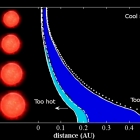Habitable Zones of Pre-Main-Sequence Stars
We calculate the pre-main-sequence HZ for stars of spectral classes F–M. The spatial distribution of liquid water and its change during the pre-main-sequence phase of protoplanetary systems is important in understanding how planets become habitable. Such worlds are interesting targets for future missions because the coolest stars could provide habitable conditions for up to 2.5 billion years post-accretion. Moreover, for a given star type, planetary systems are more easily resolved because of higher pre-main-sequence stellar luminosities, resulting in larger planet-star separation for cool stars than is the case for the traditional main-sequence (MS) habitable zone (HZ). We use 1-D radiative-convective climate and stellar evolutionary models to calculate pre-main-sequence HZ distances for F1-M8 stellar types. We also show that accreting planets that are later located in the traditional MS HZ orbiting stars cooler than a K5 (including the full range of M-stars) receive stellar fluxes that exceed the runaway greenhouse threshold, and thus may lose substantial amounts of water initially delivered to them. We predict that M-star planets need to initially accrete more water than Earth did or, alternatively, have additional water delivered later during the long pre-MS phase to remain habitable. Our findings are also consistent with recent claims that Venus lost its water during accretion.

